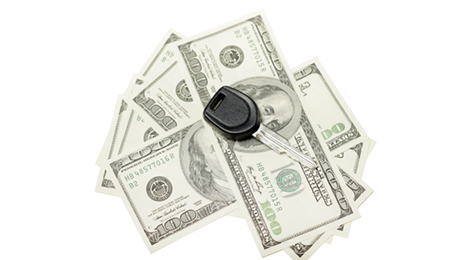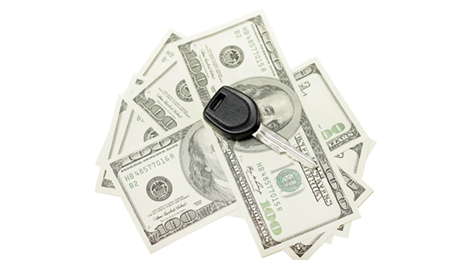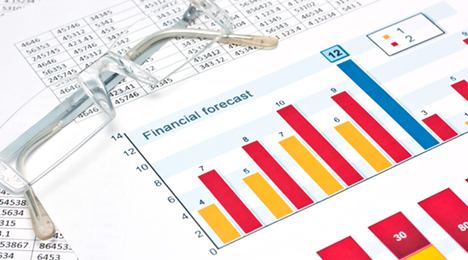Nicholas Financial top management explained intense competition for subprime paper triggered not only modifications of its infrastructure and human capital, but also how many contracts the finance company booked during the second quarter of its current fiscal year.
The company reported during the three-month span that finished Sept. 30 that it secured 3,592 contracts, down from the year-ago figure of 4,243. Halfway through its fiscal year, Nicholas Financial added 7,096 contracts, again down from the 8,845 contracts from dealerships the company collected at the midpoint of its previous fiscal year.
“During our second quarter, new-loan origination continued to be below company expectations due to numerous companies looking to acquire automobile retail installment contracts,” Nicholas Financial president and chief executive officer Ralph Finkenbrink said in a news release about its performance.
“Some of these companies are willing to acquire loans at riskier pricing, which we believe will ultimately leave those companies with unprofitable portfolios,” Finkenbrink continued.
Nicholas Financial also reported that its average contract amount and term ticked higher while its average APR dipped a bit. In Q2 of its fiscal year, average contracts stood at $11,565 for 57 months with an APR of 22.26 percent.
All told, the company indicated it held 37,383 active accounts as of Sept. 30, pushing its portfolio to $485.5 million.
As a result of its origination activity plus other market facts, Nicholas Financial mentioned in its disclosures to the Securities and Exchange Commission that it closed three branch locations as a result of these respective markets not meeting the company’s operating criteria to remain viable branch locations. The sites included Sarasota, Fla., Troy, Mich., and Toledo, Ohio, with the company moving activities to other locations already in operation within those markets.
While the company cut those locations, Nicholas Financial also noted in its SEC documents that it opened a full-service branch in Pittsburgh during Q2.
“The company continues to evaluate potential new markets while maintaining its existing markets,” Nicholas Financial said in its Form 10-Q with the SEC. “The company may choose to close or consolidate certain existing branches if they are unable to acquire contracts that meet company expectations. As a result of continued intense competition, the company has been evaluating the long-term sustainability of its current branch-based model.”
Back in the news release, Finkenbrink noted the company also moved all loan-servicing operations from the branch locations to a centralized location within its corporate headquarters in Clearwater, Fla.
“We continue to evaluate the various markets in which we operate,” Finkenbrink said. “However, we do not expect any significant changes to the number of branches or other operations during our third quarter which ends Dec. 31.”
Nicholas Financial elaborated about its personnel and infrastructure moves in the SEC document.
“New regulations and best practices regarding collections were important aspects that led us to the decision to centralize our loan servicing operations,” the company said. “To a lesser extent, the company expects to experience a decline in operating expenses as a result of a reduced headcount.
“The company does not believe there will be any material change in delinquencies and losses as a result of this strategic decision. However no assurances can be given at this time,” the company continued. “The branches will continue to underwrite and acquire contracts. However, any additional material changes to company operations will be evaluated by the company over the next several quarters.”
And speaking of delinquencies, Nicholas Financial reported that its total rate of past due accounts — ranging from just over 30 days to more than 90 days — constituted 9.79 percent of its outstanding portfolio, or about $47.3 million. After Q2 of its previous fiscal year, the company indicated those readings stood at 5.88 percent or $27.9 million.
Looking at its top-line metrics, Nicholas Financial said its Q2 diluted earnings per share decreased 40 percent to $0.25 as compared to $0.42 a year earlier. Net earnings softened to $1.97 million, down from $3.28 million.
The company noted its Q2 revenue remained relatively flat at $22.65 million.
For the six-month span that ended Sept. 30, Nicholas Financial reported that its per-share diluted net earnings decreased 30 percent to $0.62 as compared to $0.89 for six months of its 2015 fiscal year. Net earnings totaled $4.87 million, down from $6.93 million.
Through six months, revenue increased 2 percent year-over-year from $44.71 million to $45.56 million.
“Our net earnings for the three and six months ended Sept. 30 were adversely affected primarily by an increase in the provision for credit losses due to higher charge-offs and past-due accounts along with a reduction in the gross portfolio yield,” Nicholas Financial said. “Conversely, our results were favorably impacted due to a change in the fair value of the interest rate swaps.”
According to TransUnion’s Q3 2016 Industry Insights Report powered by Prama analytics, total auto financing balances grew by 9 percent year-over-year during the third quarter.
TransUnion pegged the total balance reading at $1.1 trillion, up from $1.01 trillion in Q3 2015.
Analysts noticed subprime balances experienced the largest increase, with 11.4 percent year-over-year growth. Despite this increase, subprime balances accounted for just $172 million of the $1.1 trillion in total balances in Q3.
“Subprime balance growth outpaced overall growth in the auto loan sector in the third quarter, but subprime consumers’ share of balances has remained steady in the last few years,” said Jason Laky, senior vice president and automotive and consumer lending business leader for TransUnion.
“We’re observing increased delinquency rates, but this is a natural function of more non-prime consumers with an auto loan,” Laky continued.
“We hope that steady job growth and wage gains will enable delinquencies to continue at low rates and support continued auto sales growth, though potentially at a more moderate pace than in recent years,” he went on to say.
In the third quarter, 79.3 million consumers had some kind of auto financing, up 6.2 percent from 74.7 million in Q3 of last year. The average balance per consumer was $18,361, the highest level since Q3 2009.
One year prior, the average auto financing balance was $17,946.
The report also found that auto loan delinquency, for consumers 60 days or more past due, reached 1.33 percent in Q3 2016, up from 1.19 percent in the third quarter of 2015.
Auto originations, viewed one quarter in arrears, grew at the slowest annual pace since the Great Recession. Total originations were 7.27 million in Q2 of this year, up slightly from 7.24 million in Q2 of last year.
TransUnion indicated originations to non-prime consumers — individuals with a VantageScore 3.0 score of 660 and below — declined for the first time since Q3 2010.
“The second quarter of 2016 marked the first sign of a slowdown in non-prime originations, but the flat growth in total originations was in line with the expected plateauing of new-vehicle sales,” Laky said.
Editor's note: Watch for a future report from SubPrime Auto Finance News containing more details from TransUnion's latest auto finance analysis.
With one subprime metric jumping to the second-highest point in 15 years, the latest monthly auto loan ABS index from Fitch Ratings released this week showed that losses for U.S. auto ABS continue their steady climb.
As a result, analysts noticed some finance companies are holding the line on underwriting quality.
Fitch reported that both prime and subprime auto loan ABS annualized net losses have increased in each of the last three months. Analysts indicated prime annualized net losses hit 0.70 percent — the highest rate since early 2011.
Meanwhile, subprime annualized net losses crossed the 9-percent mark for the second time this year.
Fitch determined U.S. auto loan ABS performance slowed in September due to higher losses from 2013-2015 vintage ABS and rising vehicle depreciation in the weak fall months.
Despite these negative trends, analysts pointed out loss rates across sectors are tracking within initial forecasts for outstanding Fitch-rated ABS transactions in 2016. They added prime loss rates on outstanding 2013-2015 transactions are currently tracking similar to 2004-2006 transaction losses, and well below the 2008-2009 peak recessionary levels.
“Further, prime and subprime ratings performance is solid and has not been impacted by slowing asset performance. Positive rating actions on subordinated notes in both sectors are on par with the number issued in 2015,” the firm said.
Interestingly, Fitch mentioned that some auto finance companies are attempting to curb underwriting declines to address declining asset performance.
“As a result, a number of auto ABS securitizations came to market last quarter with marginally better credit quality, including stable or marginally improved FICO scores,” analysts said.
“That said, only time will tell how long this trend will last," they continued. "And despite the pushback by some lenders, Fitch does not believe that these changes will have a significant positive influence on asset performance.”
Fitch’s data indicated prime 60-day delinquencies crept higher to 0.44 percent in September, landing 11.5 percent higher than a year ago. Annualized net losses in the prime space climbed 17.3 percent month-over-month and soared 31 percent higher than September of last year.
“The current rate is approaching loss rates consistent with latter part of 2010 and early 2011,” analysts said.
Fitch reported subprime delinquencies rose to 5.05 percent in September — the second highest level since 2001. Subprime delinquencies came in 13.2 percent higher than a year earlier.
For the second time this year, subprime annualized net losses rose above 9 percent, hitting 9.29 percent last month. That reading registered 4.6 percent higher month-over-month and 23 percent above September of last year.
“As Fitch has stated prior, subprime losses are higher due to poorer 2013-2015 vintage performance as well as a changing mix in its index,” analysts said.
“Smaller independent auto finance companies, including new market entrants with higher loss profiles, comprise a larger share of the index today versus two-to-three years ago,” they continued.
“Pressure on used-vehicle values is rising due to a combination of higher off-lease supply entering the secondary market, lower new vehicle sales and higher vehicle inventory, and higher incentive levels. This will impact loss severity and ABS performance over the next six months,” analysts went on to say.
According to Anil Goyal of Black Book, the fourth quarter typically experiences the largest depreciation in vehicle values, and this trend started to manifest itself in the first two weeks of October with the largest year-to-date weekly decline in car values.
Further, Goyal mentioned that stronger-performing trucks and SUVs — which retained values well during most of 2016 — are now starting to see an uptick in depreciation as well, driven by higher incentives on new vehicles.
Fitch’s auto loan ABS indices track the performance of $97 billion of outstanding securitized collateral. $57 billion represents prime ABS collateral (58.5 percent of the index) with the remaining 41.5 percent comprising subprime collateral. Further, the $97 billion of outstanding ABS collateral makes up only 8.8 percent of the total $1.1 trillion in auto debt outstanding.
SubPrime Forum presenting sponsor Digital Recognition Network (DRN) is participating in a free webinar to help finance companies and repossession agents to be more efficient and save precious time — and money — by better using their historical license plate recognition (LPR) scan databases.
“The repossession industry can feel like a game of hide and seek. Agents are left to rely on old addresses and outdated information to find a vehicle that someone does not want to be found,” said DRN officials, who are collaborating on the webinar with RepoPulse.com.
“But agents who use LPR technology have a tremendous tool available to them — their historical scan database,” DRN continued. “Those databases are treasure chests of sightings and patterns to help agents not just find more cars, but find more cars without driving around to more addresses. Being more efficient means more money to the bottom line.”
DRN's Brett Balint will share some of the secrets that can help agents who represent finance companies during the recovery process make the most out of their historical scan databases to find more vehicles and save time, simultaneously.
The session is set for 1 p.m. ET on Thursday.
Interested participants can register for this free event by going to this website.
The auto default reading S&P Dow Jones Indices and Experian reported for September tied the highest mark of the year, coming in at 1.05 percent.
Ticking up 4 basis points on a sequential basis left the September reading at the same point analysts spotted back in February. To find a reading higher, you have to go back to February of last year, when it stood at 1.06 percent.
September’s uptick extended the auto default rise to four months in a row, mirroring a similar pattern seen last year when this portion of the S&P/Experian Consumer Credit Default Indices also increased during four consecutive months before plateauing and eventually retreating back to the recent low point registered back in June (0.91 percent).
Meanwhile the composite reading — a comprehensive measure of changes in consumer credit defaults — stood at 0.84 percent in September, which was 1 basis point lower than the previous month and 5 basis points lower than a year earlier.
Data through September indicated the first mortgage default rate also dropped by 1 basis point to 0.67 percent while the bank card default rate hit a seven-month low at 2.76 percent, down 10 basis points from last month.
Analysts noticed four of the five major cities saw their default rates decrease in September.
Miami had the largest decrease, reporting at 1.12 percent, down 9 basis points from August.
Chicago saw its default rate decrease by 6 basis points to 0.87 percent in September, and New York reported a decrease to 0.86 percent, down 5 basis points from the previous month.
Los Angeles posted a default rate of 0.59 percent, down 1 basis point for the month.
Dallas was the only city unchanged from last month at 0.74 percent.
“Data from the Federal Reserve shows that consumer credit outstanding continues to expand,” said David Blitzer, managing director and chairman of the index committee at S&P Dow Jones Indices.
“After increasing by 7.2 percent in 2014 and 7.0 percent in 2015, growth this year is running at an annual rate of 6 percent to 7 percent,” Blitzer continued. “Despite the continued growth in total consumer credit extended and the currently very low interest rates, we are not seeing any deterioration in consumer credit defaults.
Rather, the default rates for major categories and for the five cities highlighted in this report continue to drift down to the lowest figures seen in 12 years,” he added.
Blitzer elaborated about what’s triggering those developments.
“Among the factors supporting the favorable trends in consumer credit defaults are the economy’s underlying growth and continuing gains in employment, increases in personal income and low inflation,” he said.
“A rare decline in mortgage debt outstanding and slower growth in consumer credit following the 2007-2009 recession contributed to improvements in consumers' financial condition which has been sustained in the last few years,” Blitzer went on to say.
Jointly developed by S&P Indices and Experian, analysts reiterated the S&P/Experian Consumer Credit Default Indices are published monthly with the intent to accurately track the default experience of consumer balances in four key loan categories: auto, bankcard, first mortgage lien and second mortgage lien.
The indices are calculated based on data extracted from Experian’s consumer credit database. This database is populated with individual consumer loan and payment data submitted by lenders to Experian every month.
Experian’s base of data contributors includes leading banks and mortgage companies and covers approximately $11 trillion in outstanding loans sourced from 11,500 lenders.
Consumer Portfolio Services chairman and chief executive officer Brad Bradley acknowledged that he thought the company would operate like other subprime auto finance providers during the third quarter — tightening up underwriting and not booking as much paper.
Turns out that according to Bradley, CPS modified its origination pace during Q3, but the rest of the subprime industry didn’t. But he’s not upset because, “We are doing well. We’re making money. Our numbers look pretty good.”
The specific Q3 numbers CPS reported this week included that the company purchased $242.1 million of new contracts compared to $319.1 million during the second quarter of this year and $287.5 million during the third quarter of last year. The activity pushed the company’s managed receivables total to $2.292 billion as of Sept. 30, an increase from $2.254 billion as of June 30 and $1.941 billion as of the end of last year’s third quarter.
“The numbers we can be happy with and given the circumstances in our industry, it’s really not a bad thing,” Bradley said when CPS hosted its quarterly conference call on Tuesday. “I think in a strange way over the last year or so CPS has become somewhat of a spectator in our own industry, and that’s a good thing not a bad thing.
“The good part is everyone seems to know what is going on in the industry, but no one seems to care what CPS is doing. Everybody is happy with what CPS is doing,” he continued.
The CPS results and Bradley’s comments arrived at what might be an interesting juncture. Cox Automotive chief economist Tom Webb shared this assessment back in August, noting, “As I listen to lenders, and more importantly their investors, almost unanimously they are now saying we’re at the point in the cycle where as the saying goes, ‘You manage your book; you don’t grow your book.’”
In light of that kind of sentiment, Bradley said, “In some ways, as much as we’re not wonderfully happy with our total overall performance, we’ve done pretty well.
“Ironically compared to lots of people in the industry we’ve done great,” he continued. “And so that puts us in an odd spot in that everyone is waiting to see what everyone else is going to do. How is the industry going to shake out? How are the big players going to change? What are the small people going to do?
“And so we sit in the middle. We are doing well. We’re making money. Our results are pretty good, and so we’re going to have to wait and see,” Bradley went on to say.
During the third quarter, CPS generated $7.3 million in earnings or $0.26 per diluted share. A year earlier, the company’s net income came in at $8.8 million, or $0.28 per diluted share.
The company also highlighted that its Q3 revenues jumped 15.5 percent to $108.5 million. However, the company’s total operating expenses for the third quarter grew by a higher pace — 22.6 percent — to come in at $96.1 million.
Looking at the performance of CPS’ book, the company indicated its annualized net charge-offs for the third quarter stood at 6.69 percent of the average owned portfolio as compared to 6.27 percent a year earlier.
The company’s Q3 delinquencies greater than 30 days (including repossession inventory) came in at 10.46 percent of the total owned portfolio as of Sept. 30, as compared to 8.81 percent on the same date in 2015.
So what might happen with CPS to close 2016?
“We need some sort of result in what is going to happen with the big guys, what is going to happen to the small guys,” Bradley said. “Personally in our experience of 25 years, I think our industry is well suited to pick up the new small guys. I don’t think there will be a big bunch of crashes and I think the industry itself would absorb anybody who has any problem whatsoever. But we just need all this to happen and then I think you get some closure on those two areas.
“CPS is well positioned to take advantage of the market both in terms of our size, in terms of our growth potential … we’re in a good spot,” he added.
Both S&P Global Ratings and the American Bankers Association spotted rises in auto finance delinquencies in their recent reports, but Cox Automotive chief economist Tom Webb insisted this week that the “overall financing environment remains extremely favorable.”
According to results from the ABA’s second-quarter Consumer Credit Delinquency Bulletin, both of its categories of auto financing registered slight year-over-year upticks. ABA reported direct auto loan delinquencies — contracts arranged directly through a bank — edged 1 basis point higher in Q2 from 0.81 percent to 0.82 percent.
Meanwhile, ABA noted Q2 indirect auto loan delinquencies — financing arranged through a third party such as a dealer — moved up from 1.45 percent to 1.56 percent.
And S&P Global Ratings carved out its look strictly at subprime paper and noticed the 60-plus-day delinquency rate ticked up to 4.85 percent in August 2016 from 4.74 percent in July and 4.14 percent in August of last year. Analysts acknowledged subprime delinquencies remain below the highest level, which was recorded in August 2009 at 5.19 percent.
Webb also considered where wholesale prices currently stand when evaluating how delinquencies might be impacting auto financing activity.
“There have been some lenders who have pulled back as a necessity because they became overly aggressive and they started to see it in their portfolio performance. However, there have been other players who have come in,” Webb said during his quarterly conference call. “From the dealer standpoint, the availability of financing is not an issue at all.
“From the lender standpoint, although delinquencies are ticking up a little bit, they’re not overly alarming,” he continued. “There have been some significant increases for some lenders in terms of their severity of loss. But I would suggest that would not be because of used-vehicle values but because of their loan-to-value ratio going in.”
Looking back at the ABA bulletin, the composite ratio — which tracks delinquencies in eight closed-end installment loan categories — fell 3 basis points to 1.35 percent of all accounts — a record low. This reading also marked the third year that delinquency rates were below the 15-year average of 2.21 percent.
The ABA report defines a delinquency as a late payment that is 30 days or more overdue.
“Consumers have become more confident over the past two years and for good reason — their financial picture is improving and their paychecks have finally started to rise as we near full-employment levels,” ABA chief economist James Chessen said. “Quarter after quarter, consumers continue to build a stronger balance sheet as they earn more, save more and keep debt levels low relative to income.”
So if Chessen is correct, auto finance companies might be leveraging a strategy Webb described. After all, Equifax recently reported that newly opened auto loans and installment contracts year-to-date through June and reported to Equifax as of August represented a rise of 3.5 percent versus the same period a year ago.
“Going forward, you assume that wholesale values are going to deteriorate a least a little bit. To use the same loan-to-value ratio, you’re putting more risk on your books because your loan-to-value ratio is based on current values whereas your repo might occur 16 to 18 months later,” Webb said.
“I think they have to incorporate that and I wouldn’t be surprised if everyone tries to get a little more up-front money in the deal. I think it would be better for everyone,” he went on to say.
The latest asset-backed securities analysis from S&P Global Ratings showed weakening performances for both the U.S. prime and subprime auto loan ABS sectors in August — with net losses, recovery rates and 60-plus-day delinquencies all worsening month-over-month.
Analysts added that performance for both sectors also continued to weaken year over year, with only prime recovery rates improving from a year ago.
According to the report released on Tuesday, U.S. Auto Loan ABS Tracker: September 2016, analysts noticed losses have increased in both sectors for the past three months. The prime net loss rate in August was 0.68 percent, rising from 0.61 percent in July and 0.50 percent in August of last year. The subprime net loss rate increased to 8.35 percent in August, up from 7.53 percent in July 2016 and 6.60 percent in August of last year.
S&P Global Ratings explained the year-over-year increase of 175 basis points in subprime losses is largely due to deep subprime pools representing a greater percentage of the outstanding collateral in its index.
Despite that year-over-year downward movement, analysts pointed out that credit enhancement for 'AAA' rated classes has generally kept pace with the weakened performance.
“This collateral trend indicates weaker credit quality,” S&P Global Ratings said. “The auto industry has also become intensely competitive, which has led to price competition, loosening of credit standards and higher charge-offs.”
In more recent vintages, analysts indicated much of the increase in losses is due to a greater share of total issuance from high-loss issuers. Keeping in step with the weakened collateral performance, S&P Global Ratings noted that its loss expectations for subprime auto loan ABS have generally increased since 2011 as well.
“While our loss expectations are at historically high levels since 2011, our analysis shows that credit enhancement for classes rated 'AAA' in subprime auto loan ABS transactions has increased,” analysts said. “For these classes, we calculated the weighted average initial credit enhancement at closing and the break-even amount of credit enhancement based on transaction-appropriate assumptions for prepayment rates, loss timing, and recovery rates to support 'AAA' ratings.
“Both the initial percentage of hard credit enhancement (excluding excess spread) at closing and the weighted average break-even level increased to higher levels for 'AAA' rated classes in transactions issued in 2015 and 2016 compared with those issued in prior periods,” analysts continued.
Turning back to the latest data, S&P Global Ratings also offered a supplement to its subprime index — creating a modified subprime index — which excludes certain high-loss deep subprime issuers.
Analysts pointed out that the modified subprime net loss rate of 6.59 percent for August was significantly lower than the overall subprime index loss rate of 8.35 percent and demonstrated less deterioration, increasing only 62 basis points year-over-year.
Returning to the overall data, the latest report noted the recovery rate for the prime sector decreased to 54.87 percent in August from 57.83 percent in July. Recoveries in the prime space improved year-over-year from 52.07 percent spotted last August.
Meanwhile in subprime, S&P Global Ratings found the recovery rate decreased to 37.34 percent in August, down from 38.86 percent in July. Subprime recoveries also decreased year-over-year from 40.63 percent seen last August.
Since May, analysts indicated recovery rates for the subprime sector have been on a downward trajectory. Referring back to their modified data set, analysts said the subprime recovery rate in August was 37.97 percent compared with 39.56 percent in July and 42.30 percent in August of last year.
Turning next to delinquencies, S&P Global Ratings determined the prime 60-plus-day rate increased to 0.50 percent in August from 0.47 percent in July and 0.41 percent in August of last year.
On the subprime side, analysts indicated the 60-plus-day delinquency rate ticked up to 4.85 percent in August 2016 from 4.74 percent in July and 4.14 percent in August of last year. They acknowledged subprime delinquencies remain below the highest level, which was recorded in August 2009 at 5.19 percent.
Touching on that modified data one more time, S&P Global Ratings calculated that the subprime 60-plus-day delinquency rate came in at 3.71 percent in August compared with 3.66 percent in July and 3.50 percent in August of last year.
“Similar to losses, the increased mix of newer, deep subprime auto loan shelves is negatively affecting delinquencies,” S&P Global Ratings credit analyst Amy Martin said.
Before arriving at Equifax, both Lou Loquasto and Craig Sims spent time in the industry trenches with auto finance companies, competing against other providers for applications and contracts generated at dealerships.
When Loquasto and Sims offered the industry media a glimpse of Equifax’s newest tool — TradeSight — the availability of this marketplace intelligence platform made them both harken back to how it could have made their tenure with finance companies even more fruitful.
Combining Equifax consumer credit information with dealer and vehicle data from third-party sources, TradeSight can enable auto finance companies to assess their dealer network, benchmark against their peers and better understand a dealer’s commercial risk.
“In all the years I’ve been in auto finance, this is the most excited I’ve been about a product,” said Loquasto, Equifax’s vice president. “It has to do with dealer risk, helping lenders in what is a very competitive environment.
“We took that track that when we were lenders, what did we want as far as a dealer and business intelligence tool? That’s what we produced,” he continued during that sneak peek of the tool that officially launched on Wednesday.
It took Equifax nearly two years to develop the tool in response to finance companies’ need to assess opportunities within a sector that is increasingly competitive, particularly with the emergence of nontraditional financing providers.
Leveraging data from industry leaders such as Black Book and IHS Automotive, TradeSight can provide comprehensive analytics from a single platform that can uniquely provide market insights into contract-level analysis. This analysis can enable lenders to adjust terms offered to consumers to track dealer performance in support of portfolio growth.
Offering data on the last 48 months of originations and providing regular updates, TradeSight is designed to help finance companies assess:
—Percentage of loans being directed to them from certain dealerships
—Types of loans most and least frequently initiated at those dealerships
—Current and historical loan performance
—Positive and negative selection among their dealer network
—Commercial risks of each dealership
Sims, the Equifax auto lending sales leader, explained the tool capabilities this way: “Am I the first choice lender or am I the last choice lender? Am I getting the best deals or am I getting the worst deals? Now lenders will be able to see that performance within a single dealership or dealer group.”
Loquasto added that finance companies will be able to see if a top competitor “is getting aggressive with this (specific) dealership. Then I need to spend more time with this dealership. We may need to do something because I need to compete with the other folks.”
Sims insisted TradeSight was built to evolve with the needs of the auto finance industry, and Equifax plans to continue to incorporate more data sources into the platform over time. Along with this pledge, Sims mentioned finance companies have the option of directly accessing the market intelligence tool or requesting customized reports based on their individual needs. He added this customized approach will enable them to acquire the specific data they need to manage the specific risk that may exist within their dealer network.
Touching on why it took such an effort and collaboration, Sims said, “It just takes a while to pull all of those pieces together to make sure they’re buttoned up and ready for prime time.”
For more information about TradeSight, finance companies and dealerships can contact their Equifax sales representative.
“Automotive lending has long been a highly competitive market and with the industry becoming increasingly more complex, driving an increasing need for more relevant and timely market insights,” Loquasto said in Equifax’s announcement.
“As a result, we recognized an opportunity to incorporate the loan-level data on hand and pair it with some of our industry partners to create TradeSight, which delivers a comprehensive snapshot of the auto lending marketplace,” he went on to say.
When Equifax looked at its most recent auto finance data, analysts considered the trend that finance companies might be tightening their underwriting a bit.
Still based on the August Equifax National Consumer Credit Trends Report, analysts noticed what they called “healthy growth” in originations. Equifax indicated that newly opened auto loans and installment contracts year-to-date through June and reported to Equifax as of August represented a rise of 3.5 percent versus the same period a year ago.
Analysts noted that balances on new originations grew 5.5 percent. Perhaps what triggered the tightening thought, they added that the share of financing originated to borrowers with an Equifax Risk Score of less than 620 — generally considered to be subprime accounts — fell 0.6 percent versus the first six months of 2015.
“Lenders in general have been very risk averse since the Great Recession, with more and more using all the tools available to accurately rate and price the risks they are taking and to sensibly decide which ones they don’t want to take,” said Amy Crews Cutts, chief economist at Equifax.
“Lending in the subprime segment can be done well and to the mutual benefit of consumers and lenders, provided the whole credit-collateral-capacity picture of the loan is healthy. In recent months there has been a shift in the share of new loans going to higher-credit quality borrowers, possibly indicating tightening of lending standards,” Crews Cutts continued.
Equifax indicated performance of the auto finance market is holding steady at very low levels.
As of August, the severe delinquency rate (defined as share of balances that are 60 days or more past due) stood at 1.05 percent, which is a slight increase of 7 basis points over August of last year.
The write-off rate is at 21.2 basis points, which is an increase of 1.8 basis points year-over-year.
Delinquencies, including seasonal variations, have stayed tightly within the range of 0.8 percent to 1.25 percent since March of 2013 while write-off rates have varied between 18.2 and 23.0 basis points.
“The market is starting to see slowing demand, which means lenders will have to contend with increased competition for consumer loans which will drive a need for increased market intelligence to properly identify and mitigate risk in this environment,” said Lou Loquasto, vice president at Equifax, who will be one of the experts on hand for the SubPrime Forum during Used Car Week at the Red Rock Resort and Casino in Las Vegas on Nov. 14-18.
Equifax insisted that consumer credit data is the most accurate way to assess a consumer’s financial health and a useful tool in assessing current performance of the auto lending industry. In line with this assessment and in response to the need for enhanced market intelligence in the auto lending environment, Equifax plans to announce details around its new auto finance market intelligence platform later this week.
Other highlights from the report include:
—As of August, auto finance portfolio balances are growing at a higher rate year-over-year for banks than finance companies (10.6 percent and 6.8 percent respectively). Year-over-year growth rates in the number of auto accounts are slightly lower for finance companies (4.9 percent) than banks (7.0 percent).
—In August auto leasing showed signs of growth for both banks and finance companies, with a 14.1 percent and 16.1 percent year-over-year increase, respectively.
—Year-over-year consumers are spending more on the vehicles they are purchasing. The average origination amount for all auto contracts issued in June was $21,392. This figure marked a 3.5 percent increase over June of last year.












